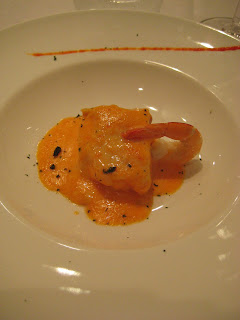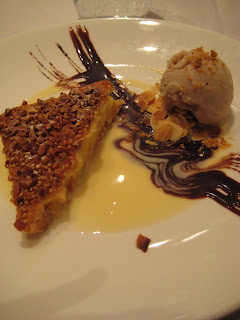I’ve never had a tasting menu before. I’ve always understood it to mean a menu designed by the chef to show off his skills, providing a range of flavors in one meal. I never knew it meant death by gluttony, albeit a slow and pleasurable one.
I’ve finally woken up to the fact that I only have a few days left in Spain and even fewer left in San Sebastian. I’ve spent less money than I expected, and so it is time to spend my surplus! But the cheapo cynic in me still isn’t interested in spending 100+ Euros at Arzak, or even 55 Euros at Kokotxo. Another student at Lacunza, a retiree with enough money to spend at more expensive places, said one of his favorite meals was the 36-Euro menú de degustación at Casa Urbano. And so off I went.
On a Monday afternoon, Casa Urbano was quiet, just a few pairs dining in the calm, cream-colored restaurant. There was abstract art involving wood branches and cream-colored squares on the walls, nothing very interesting, but nothing very offensive either, and the waiters were very kind. Even if it isn’t a Michelin-starred restaurant, it declared itself still to be some place special, with white tablecloths, strong napkins, and even buckets of ice for white wine at each table. After all the inner strength I’ve mustered to enter bustling and noisy tapas bars solo, it was a breeze to sit down in that quiet restaurant by myself. I didn’t feel like everyone was having so much more fun than me. The middle-aged couple in front of me barely said a word to each other throughout their entire meal.
The menu was more intricate than I’d understood from reading it outside—you got to try all three appetizers listed, with the option of switching one out for the daily special; your choice of an entrée or two half-portions of two entrees; and then your choice of a dessert or two half-portions of two desserts, plus wine, bread, and bottled water. Of course I maximized my options, which meant I had seven plates set in front of me. So be warned, the following is very long.

But I’ll start with the wine, which was a choice between house white, house red, and txakoli, the very drinkable, slightly fizzy young Basque white wine. When I chose the txakoli, I was presented with the entire bottle, so it sat dangerously in front of me throughout the meal.

First came the pastel de esparragos y langostinos, a little soft mousse-like cake of pureed asparagus and shrimp, with a delicate little shrimp on top. It sat in a little sauce that was so good, I sopped it all up with my bread, little understanding what I had ahead of me. I loved that it was
nouveau but still soft and comforting, though my first bite indicated that there was one big problem with the restaurant—prepped food isn’t properly being allowed to come to room temperature.

Then came the ensalada temporada de chipiron, a warm baby squid salad. I loved the crispy grilled legs and the olive oil generously dressing the squid in its own ink. But again, sadly, the potatoes were cold, though the olive on top was fantastic.

I swapped the third appetizer for the daily special, pimiento relleno con queso y anchoa, and was glad I did because it was my favorite of the three. The roasted red pepper encased a perfect cylinder of a firm, white cheese, but what made it special was something that I couldn’t quite place, that nagged and nagged me until I realized they had somehow caramelized an anchovy! It was the perfect combination of sweet and salty. I’m not clever enough to figure out what the white sauce underneath was, some sort of emulsion, but it was also good enough for me to eat the rest of my rather large roll. I didn’t know it at the time, but this was the beginning of the end.

Ha! The “Gilda” de bonito fresco con refrito al vinagre de sidra, or a tapa of fresh tuna with delicious fried bits of garlic, little green peppers, and dried red peppers, in olive oil and Basque cider vinaigrette was not a “tapa” as described on the English menu. The “Gilda” refers to a famous San Sebastian pintxo of olives, pickled peppers and an anchovy, all skewered together and created in homage to the Rita Hayworth movie, “Gilda.” It’s supposed to be as surprisingly sexy. It was delicious, and the tuna was fantastic also, just seared so that the inside stayed a warm red. It sat in a literal bath of olive oil, but it didn’t overwhelm the simple, fresh flavor of the fish.

By the time my second entrée arrived, I was starting to feel ill. But I couldn’t stop; it was like I was in a trance. Besides, it was magret de pato al agridulce de frambuesa, or duck, one of my favorite meats in the world, in a raspberry sauce. I normally hate the words “raspberry sauce,” but the sauce here was delicate and tart, as well as sweet, and my aching stomach didn’t stop me from eating all of the butternut squash puree, too, which had a strong, tart apple flavor. I did leave one chunk of potato.

When the waiter came to take my dessert order, some part of me knew I had to stop, but the rest of me didn’t want to listen. At this point, I couldn’t plead ignorance of what this restaurant considered a “half-portion,” but I still ordered two desserts. The pantxineta crujiente “Gorrotxategi” was a flaky, crispy almond tart layered with a lovely rich cream. As if that weren’t enough, it was served with a scoop of nutty ice cream that I think was also almond-flavored.

Given how truly ill I was feeling at this point, I thought I should have some fruit: fruta asada de temporada con su subayon, or roasted seasonal fruit of pineapple, peach, and strawberries in subayon. Again, the fruit was a little too cold, but the “subayon” turned out to be a frothy, almost foamy (Spanish foam again!) tart sauce that must have had some milk or cream in it, because caramelizing the top had created a little skin. I wanted to die
and I was drunk.
The waiter was surprised when I ordered my espresso before the second dessert arrived, saying, “But you’re still missing one dessert!” But I needed it immediately, some injection of caffeine and energy that would allow me to carry my bloated body back home and into my bed.
The really scary thing is that four hours later, I thought, hmm, I should buy some bread to eat for dinner with the duck pate in the fridge.
(If you’re wondering if you should subject yourself to this particular slow death the next time you’re in San Sebastian, I thought the coldness of the food really was a problem, with the insides of all the seared meats and even the roasted fruits being just too cold. I don’t want to sound like a restaurant critic, but a fine restaurant should not let that happen. That said, it was a lot of excruciating fun at a very good price, and if you don’t want to die eating seven courses, the a la carte menu is quite reasonably priced as well.)



















